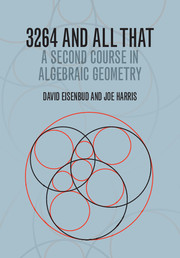Book contents
- Frontmatter
- Contents
- Preface
- Chapter 0 Introduction
- Chapter 1 Introducing the Chow ring
- Chapter 2 First examples
- Chapter 3 Introduction to Grassmannians and lines in ℙ3
- Chapter 4 Grassmannians in general
- Chapter 5 Chern classes
- Chapter 6 Lines on hypersurfaces
- Chapter 7 Singular elements of linear series
- Chapter 8 Compactifying parameter spaces
- Chapter 9 Projective bundles and their Chow rings
- Chapter 10 Segre classes and varieties of linear spaces
- Chapter 11 Contact problems
- Chapter 12 Porteous' formula
- Chapter 13 Excess intersections and the Chow ring of a blow-up
- Chapter 14 The Grothendieck Riemann–Roch theorem
- Appendix A The moving lemma
- Appendix B Direct images, cohomology and base change
- Appendix C Topology of algebraic varieties
- Appendix D Maps from curves to projective space
- References
- Index
Chapter 8 - Compactifying parameter spaces
Published online by Cambridge University Press: 05 March 2016
- Frontmatter
- Contents
- Preface
- Chapter 0 Introduction
- Chapter 1 Introducing the Chow ring
- Chapter 2 First examples
- Chapter 3 Introduction to Grassmannians and lines in ℙ3
- Chapter 4 Grassmannians in general
- Chapter 5 Chern classes
- Chapter 6 Lines on hypersurfaces
- Chapter 7 Singular elements of linear series
- Chapter 8 Compactifying parameter spaces
- Chapter 9 Projective bundles and their Chow rings
- Chapter 10 Segre classes and varieties of linear spaces
- Chapter 11 Contact problems
- Chapter 12 Porteous' formula
- Chapter 13 Excess intersections and the Chow ring of a blow-up
- Chapter 14 The Grothendieck Riemann–Roch theorem
- Appendix A The moving lemma
- Appendix B Direct images, cohomology and base change
- Appendix C Topology of algebraic varieties
- Appendix D Maps from curves to projective space
- References
- Index
Summary
Keynote Questions
(a) (The five conic problem) Given five general plane conics C1, …, C5 ⊂ ℙ2, how many smooth conics C ⊂ ℙ2 are tangent to all five? (Answer on page 308.)
(b) Given 11 general points p1,…,p11 ϵ ℙ2 in the plane, how many rational quartic curves C ⊂ ℙ2 contain them all? (Answer on page 321.)
All the applications of intersection theory to enumerative geometry exploit the fact that interesting classes of algebraic varieties—lines, hypersurfaces and so on—are themselves parametrized by the points of an algebraic variety, the parameter space, and our efforts have all been toward counting intersections on these spaces. But to use intersection theory to count something, the parameter space must be projective (or at least proper) so that we have a degree map, as defined in Chapter 1. In the first case we treated in this book, that of the family of planes of a certain dimension in projective space, the natural parameter space was the Grassmannian, and the fact that it is projective is what makes the Schubert calculus so useful for enumeration. When we studied the questions about linear spaces on hypersurfaces, we were similarly concerned with parameter spaces that were projective—the Grassmannian (k,n) and, in connection with questions involving families of hypersurfaces, the projective space ℙN of hypersurfaces itself. These spaces have an additional feature of importance: a universal family of the geometric objects we are studying, or (amounting to the same thing) the property of representing a functor we understand. This property is useful in many ways, first of all for understanding tangent spaces, and thus transversality questions.
In many interesting cases, however, the “natural” parameter space for a problem is not projective. To use the tools of intersection theory to count something, we must add points to the parameter space to complete it to a projective (or at least proper) variety. It is customary to call these new points the boundary, although this is not a topological boundary in any ordinary sense—the boundary points may look like any other point of the space—and (more reasonably) to call the enlarged space a compactification of the original space.
- Type
- Chapter
- Information
- 3264 and All ThatA Second Course in Algebraic Geometry, pp. 289 - 322Publisher: Cambridge University PressPrint publication year: 2016

